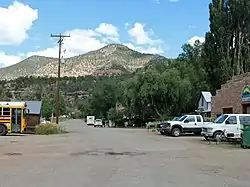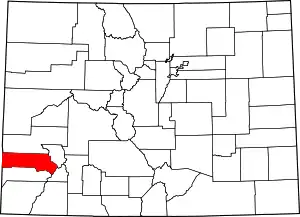Placerville, Colorado | |
|---|---|
 Front Street in Placerville. | |
 Placerville Location of the Placerville CDP in the State of Colorado. | |
| Coordinates: 38°00′18″N 108°02′22″W / 38.0051085°N 108.0395110°W[1] | |
| Country | |
| State | |
| County | San Miguel County |
| Government | |
| • Type | unincorporated community |
| Area | |
| • Total | 0.757 sq mi (1.961 km2) |
| • Land | 0.757 sq mi (1.961 km2) |
| • Water | 0.000 sq mi (0.000 km2) |
| Elevation | 7,408 ft (2,258 m) |
| Population (2020) | |
| • Total | 362 |
| • Density | 480/sq mi (180/km2) |
| [3] | |
| Time zone | UTC-7 (MST) |
| • Summer (DST) | UTC-6 (MDT) |
| ZIP Code[4] | 81430 |
| Area code | 970 |
| GNIS feature[2] | Placerville CDP |
Placerville is a census-designated place (CDP) and post office in and governed by San Miguel County, Colorado, United States. The Placerville post office has the ZIP Code 81430 (post office boxes).[4] At the United States Census 2020, the population of the Placerville CDP was 362.[3]
History
Placerville was originally established as a small mining camp, named after the placer gold mines located on the San Miguel River and Leopard Creek. The location became known as Old Placerville after the Rio Grande Southern Railroad constructed a depot and several passing sidings west of the original settlement, calling it Placerville.
A. B. Frenzel discovered vanadium-bearing sandstone near Placerville in the late 1890s. The ore was in strataform bodies in the Entrada Sandstone (Jurassic) east of the town. The principal mineral was roscoelite, with minor montroseite and carnotite. By the fall of 1899, development was described as "of the most superficial character," although Frenzel had driven one tunnel 18 feet into the rock.[5] By 1901-1902, Frenzel was excavating several thousand tons intended for shipment to Europe.[6] Most of the Placerville ore was less than 3% vanadium, too low grade to pay for shipment to Europe, so in 1905 the Vanadium Alloys Co. built an ore-processing mill southeast of Placerville to recover the metal as ferro-vanadium, which it sold.[7] At least five mines were active at one time, and by 1919 the two ore mills at Placerville were producing 30% of the world's vanadium.[8] Through 1940, the mines produced about 3.7 million pounds of vanadium.[9]
The Placerville Schoolhouse, a one-room schoolhouse, operated from 1908 to 1960.
In 1909, the failure of the Trout Lake Dam caused the flooding of Placerville as well as Sawpit and Newmire.[10]
Although carnotite was recognized as a minor constituent of the ore since its discovery, the amount was small, and no assays were made of the uranium content of the ore until World War II.[11] Beginning about 1950, the small uranium content of the ore was also recovered from the ore.[12]
Geography
The Placerville CDP has an area of 485 acres (1.961 km2), all land.[1]
Climate
According to the Köppen Climate Classification system, Placerville has a warm-summer humid continental climate, abbreviated "Dfb" on climate maps. The hottest temperature recorded in Placerville was 95 °F (35.0 °C) on July 23, 2020 and June 12–13, 2021, while the coldest temperature recorded was −17 °F (−27.2 °C) on February 2, 2011 and January 15, 2013.[13]
| Climate data for Placerville, Colorado, 1991–2020 normals, extremes 2008–present | |||||||||||||
|---|---|---|---|---|---|---|---|---|---|---|---|---|---|
| Month | Jan | Feb | Mar | Apr | May | Jun | Jul | Aug | Sep | Oct | Nov | Dec | Year |
| Record high °F (°C) | 62 (17) |
64 (18) |
72 (22) |
80 (27) |
87 (31) |
95 (35) |
95 (35) |
93 (34) |
92 (33) |
86 (30) |
71 (22) |
63 (17) |
95 (35) |
| Mean daily maximum °F (°C) | 40.1 (4.5) |
42.6 (5.9) |
51.6 (10.9) |
58.2 (14.6) |
67.9 (19.9) |
79.8 (26.6) |
83.0 (28.3) |
79.7 (26.5) |
73.9 (23.3) |
61.8 (16.6) |
49.8 (9.9) |
40.4 (4.7) |
60.7 (16.0) |
| Daily mean °F (°C) | 26.3 (−3.2) |
29.2 (−1.6) |
36.9 (2.7) |
43.2 (6.2) |
51.4 (10.8) |
62.2 (16.8) |
66.7 (19.3) |
64.4 (18.0) |
57.9 (14.4) |
45.8 (7.7) |
34.3 (1.3) |
26.4 (−3.1) |
45.4 (7.4) |
| Mean daily minimum °F (°C) | 12.5 (−10.8) |
15.7 (−9.1) |
22.3 (−5.4) |
28.3 (−2.1) |
34.9 (1.6) |
44.6 (7.0) |
50.3 (10.2) |
49.1 (9.5) |
41.9 (5.5) |
29.8 (−1.2) |
18.8 (−7.3) |
12.3 (−10.9) |
30.0 (−1.1) |
| Mean minimum °F (°C) | −4.7 (−20.4) |
−3.2 (−19.6) |
5.9 (−14.5) |
14.2 (−9.9) |
24.2 (−4.3) |
32.4 (0.2) |
42.4 (5.8) |
42.6 (5.9) |
30.4 (−0.9) |
16.5 (−8.6) |
4.7 (−15.2) |
−6.6 (−21.4) |
−9.1 (−22.8) |
| Record low °F (°C) | −17 (−27) |
−17 (−27) |
−6 (−21) |
4 (−16) |
19 (−7) |
29 (−2) |
34 (1) |
32 (0) |
24 (−4) |
2 (−17) |
−12 (−24) |
−16 (−27) |
−17 (−27) |
| Average precipitation inches (mm) | 1.42 (36) |
1.53 (39) |
1.83 (46) |
1.61 (41) |
1.83 (46) |
0.81 (21) |
2.47 (63) |
2.56 (65) |
2.52 (64) |
2.17 (55) |
1.62 (41) |
1.15 (29) |
21.52 (546) |
| Average snowfall inches (cm) | 13.1 (33) |
12.5 (32) |
13.2 (34) |
9.3 (24) |
1.3 (3.3) |
0.1 (0.25) |
0.0 (0.0) |
0.0 (0.0) |
0.3 (0.76) |
2.6 (6.6) |
10.2 (26) |
13.6 (35) |
76.2 (194.91) |
| Average extreme snow depth inches (cm) | 13.8 (35) |
17.2 (44) |
10.6 (27) |
4.1 (10) |
1.4 (3.6) |
0.0 (0.0) |
0.0 (0.0) |
0.0 (0.0) |
0.0 (0.0) |
2.3 (5.8) |
6.1 (15) |
10.9 (28) |
18.3 (46) |
| Average precipitation days (≥ 0.01 in) | 7.6 | 8.4 | 8.6 | 8.8 | 7.4 | 4.5 | 9.6 | 13.6 | 9.8 | 7.0 | 6.2 | 7.9 | 99.4 |
| Average snowy days (≥ 0.1 in) | 6.6 | 7.5 | 6.6 | 4.5 | 0.8 | 0.1 | 0.0 | 0.0 | 0.3 | 1.3 | 4.1 | 6.1 | 37.9 |
| Source 1: NOAA[14][15] | |||||||||||||
| Source 2: National Weather Service (mean maxima and minima, snow depth 2008-2022)[13] | |||||||||||||
Demographics
| Year | Pop. | ±% |
|---|---|---|
| 2020 | 362 | — |
| Source: United States Census Bureau | ||
The United States Census Bureau defined the Placerville CDP for the United States Census 2020.
Transportation
Placerville is part of Colorado's Bustang network. It is on the Durango-Grand Junction Outrider line.[16]
See also
References
- 1 2 3 "State of Colorado Census Designated Places - BAS20 - Data as of January 1, 2020". United States Census Bureau. Retrieved January 3, 2021.
- 1 2 3 "U.S. Board on Geographic Names: Domestic Names". United States Geological Survey. Retrieved January 3, 2021.
- 1 2 United States Census Bureau. "Placerville CDP, Colorado". Retrieved February 17, 2023.
- 1 2 "Look Up a ZIP Code". United States Postal Service. Retrieved January 3, 2021.
- ↑ F. L. Ransome, Occurrence of the uranium and vanadium ores, American Journal of Science, Aug 1900, v.10, n.56, p.121-127.
- ↑ Harry E. Lee (1903) Report of the Colorado State Bureau of Mines for the Years 1901-1902, p.201.
- ↑ Frank L. Hess (1913) Notes on the vanadium deposits near Placerville, Colorado, in Contributions to Economic Geology, 1911, US Geological Survey, Bulletin 530, p.142-156.
- ↑ William L. Chenowith (1980) Uranium in Colorado, in Colorado Geology, Denver: Rocky Mountain Association of Geologists, p.217.
- ↑ R.P. Fischer and others (1947) Vanadium deposits near Placerville, San Miguel County, Colorado, Colorado Scientific Society Proceedings, v.15 n.3, p.120.
- ↑ "Disastrous Flood! Sweeps South Fork". The Daily Journal. September 6, 1909.
- ↑ A.L. Bush and others (1959) Areal geology of the Placerville Quadrangle, San Miguel County, Colorado, US Geological Survey, Bulletin 1072-E, p.373.
- ↑ R.P. Fischer (1968) Vanadium deposits of the Placerville area, San Miguel County, Colorado, in San Juan-San Miguel-La Plata Region, New Mexico and Colorado, New Mexico Geological Society, p.100-103.
- 1 2 "NOAA Online Weather Data – NWS Grand Junction". National Weather Service. Retrieved November 10, 2022.
- ↑ "U.S. Climate Normals Quick Access – Station: Placerville, CO". National Oceanic and Atmospheric Administration. Retrieved November 10, 2022.
- ↑ "U.S. Climate Normals Quick Access – Station: Placerville 3SE, CO". National Oceanic and Atmospheric Administration. Retrieved November 10, 2022.
- ↑ "Bustang Schedule". RideBustang. CDOT.
